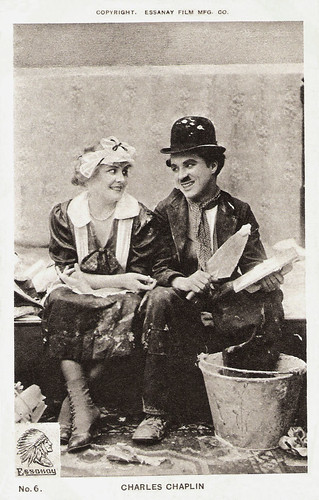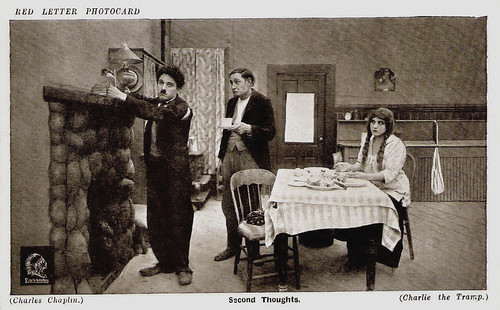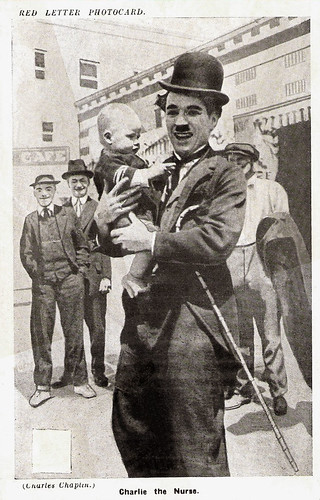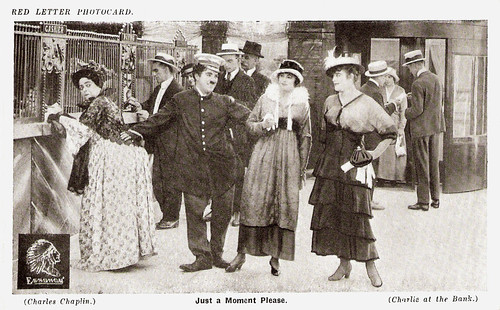The closing event of the Pordenone Silent Film Festival is a screening of Charles Chaplin's The Pilgrim (1923) and Buster Keaton's Sherlock Jr. (1924), for which a new orchestral score was created. At EFSP we focus on a special series of Chaplin postcards. Red Letter photocards was a British series of sepia-tinted postcards with pictures of the films Charlie Chaplin made for the Essanay Studio in 1915 such as The Tramp, Shanghaied, A Woman By the Sea and The Bank. The complete series contains 26 postcards, but 19 are yet in our collection.
Image may be NSFW.
Clik here to view.
British postcard by Red Letter. Photo: Essanay. Charlie Chaplin in The Champion/Champion Charlie (Charles Chaplin, 1915). Caption: Charlie and the Bulldog.
Image may be NSFW.
Clik here to view.
British postcard by Red Letter. Photo: Essanay. Charlie Chaplin in A Night Out/His Night Out (Charles Chaplin, 1915). Caption: A Small Flirtation (Charlie's Night Out). The man left of Chaplin is Ben Turpin. The man on the right is Leo White, who plays the French Count/dandy while his companion is Eva Sawyer. In the back, the head waiter, played by Bud Jamison.
Image may be NSFW.
Clik here to view.
British postcard by Red Letter. Photo: Essanay. Charlie Chaplin in Work (Charles Chaplin, 1915). Caption: Charlie the House Decorator (Charlie at Work). The man right of Chaplin is Charles Inslee.
Image may be NSFW.
Clik here to view.
British postcard by Red Letter. Photo: Essanay. Charlie Chaplin and Edna Purviance in In the Park (Charles Chaplin, 1915). Caption: Scene, Charlie in the Park (Charlie in the Park).
Image may be NSFW.
Clik here to view.
British postcard by Red Letter. Photo: Essanay. Charlie Chaplin in By the Sea/Charlie's Day Out (Charles Chaplin, 1915). Caption: Charlie's Day Out (Snapped on Los Angeles Beach). Almost unrecognisable because of the drawn face is Edna Purviance. NB There is no dog in the film.
Image may be NSFW.
Clik here to view.
British postcard by Red Letter. Photo: Essanay. Charlie Chaplin in His New Job (Charles Chaplin, 1915), also with Charles Inslee as the director, Charlotte Mineau as the film star, and Leo White as the leading man. Caption: Charlie Becomes a Star (Charlie's New Job).
Image may be NSFW.
Clik here to view.
British postcard by Red Letter. Photo: Essanay. Charlie Chaplin is a janitor in The Bank (Charles Chaplin, 1915). The man right of Chaplin is John Rand, a salesman who proves to be a robber. Caption: Charlie the Messenger (Charlie at the Bank).
Image may be NSFW.
Clik here to view.
British postcard by Red Letter. Photo: Essanay. Charlie Chaplin in Shanghaied (Charles Chaplin, 1915). The man right of Chaplin is Lawrence Bowes, who plays the ship's mate. Caption: "'I've come aboard, sir." (Shanghaied.)
Image may be NSFW.
Clik here to view.
British postcard by Red Letter. Photo: Essanay. Charlie Chaplin in A Woman (Charles Chaplin, 1915). Left, Edna Purviance as the daughter and right, Marta Golden as the mother. Caption: Charlie "The Perfect Lady."
Image may be NSFW.
Clik here to view.
British postcard by Red Letter. Photo: Essanay. Charlie Chaplin in A Woman (Charles Chaplin, 1915), also with Edna Purviance as the daughter and Charles Inslee as the father. Caption: Charlie in the Shivers (Charlie the Perfect Lady.)
In November 1914, Charles Chaplin left Mack Sennett's Keystone Film Company and signed on at the Essanay Film Manufacturing Company, where he made 14 films plus a cameo appearance in Broncho Billy Anderson's film His Regeneration. After the expiration of his one-year contract with Keystone, Chaplin was lured to Essanay, founded in 1907, for the unprecedented salary of $1,250 per week, with a bonus of $10,000 for merely signing with the company and his own production unit. The fourteen short films he made for Essanay were distinctly marked and designated upon release as the “Essanay-Chaplin Brand.”If the early slapstick of the Keystone comedies represents Chaplin’s cinematic infancy, the films he made for Essanay are his adolescence. The Essanays find Chaplin in transition, taking greater time and care with each film, experimenting with new ideas, and adding flesh to the Tramp character that would become his legacy. Chaplin’s Essanay comedies reveal an artist experimenting with his palette and finding his craft.
While no single Chaplin film for Essanay displays the aggregate transformation to the more complex, subtle filmmaking that characterises his later work, these comedies contain a collection of wonderful, revelatory moments, foreshadowing the pathos (The Tramp), comedic transposition (A Night Out), fantasy (A Night Out), gag humour (The Champion), and irony (Police), of the mature Chaplin films to come. The most celebrated of the Essanay comedies, The Tramp is regarded as the first classic Chaplin film. It is noteworthy because of Chaplin’s use of pathos in situations designed to evoke pity or compassion toward the characters, particularly the Tramp. An innovation in comedic filmmaking, The Tramp dares to have a sad ending. Pathos also appears in The Bank, in which Charlie’s heart is broken when the object of his affection throws away the flowers he has given her and tears up the accompanying love note.
Jeffrey Vance at Charlie Chaplin.com: "Nowhere is the evidence of Chaplin’s growing cinematic maturity more evident than in the subtle evolution of the Tramp’s treatment of women in the Essanay comedies. At Essanay, Chaplin found Edna Purviance, who would remain his leading lady until A Woman of Paris (1923). Born Olga Edna Purviance in Nevada in 1895, she had trained as a secretary and was recommended to Chaplin by an Essanay employee as a beautiful young woman who frequented a popular San Francisco café. Chaplin was instantly captivated by her beauty and charm. The personal chemistry between Chaplin and Purviance served the Tramp’s changing attitudes toward women well, resulting in no small part from the intimate relationship the two enjoyed off-screen. In the Keystone comedies, the Tramp was usually at odds with the women in his life, such as his frequent foil Mabel Normand. Purviance was far more demure and refined, and the Tramp’s interplay with her is gentle and often romantic. Although the female characters of the first Essanays are indistinguishable from those of the Keystones (more often than not, objects of desire, derision, or simply unimportant to the plot), beginning with The Champion, there is a softening in the Tramp’s attitude toward women. The romantic longing at the beginning of A Jitney Elopement demonstrates this transformation.
The evolution of the Tramp was undoubtedly fueled by Chaplin’s efforts to seize greater creative control over his films. Unlike the Keystone comedies, which have a simple plot and place primacy on farce humour, Chaplin’s Essanay comedies display more sophisticated plots and involve more textured characters. The maddening pace of producing nearly one new Keystone comedy each week was reflected in the rapid pace and formulaic storylines in the films. However, the pace of Essanay was somewhat slower, allowing Chaplin to take more time and care in creating his films, and more room to experiment. The tempered pace shows in the style of the films, which contain more subtle pantomime and character development. Although the first seven films Chaplin made for Essanay were released over three months, Chaplin slowed the pace of production to one two-reel film per month after that.
Chaplin had disagreements with Essanay from the beginning. The company’s co-founder, George K. Spoor, had never heard of Chaplin and was reluctant at first to give him his promised $10,000 signing bonus. Chaplin also refused to allow Essanay’s practice of projecting the original negative when screening rough film footage, which saved the studio the expense of making a positive copy, insisting that viewing prints had to be made." Chaplin disliked the unpredictable weather of Chicago and left after only one year for more money and more creative control elsewhere. His departure caused a rift between founders Spoor and G.M. Anderson, better known as 'Broncho Billy' Anderson, cinema’s first cowboy star. Chaplin was the studio's biggest moneymaker, and Essanay resorted to creating "new" Chaplin comedies from file footage and out-takes. Finally, with Chaplin off the Essanay scene for good, Essanay signed French comedian Max Linder, whose clever pantomime, often compared to Chaplin's, failed to match Chaplin's popularity in America. Chaplin remained bitter about this period in his career for the rest of his life.
Image may be NSFW.
Clik here to view.![Charlie is Shanghaied (Shanghaied)]()
British postcard by Red Letter. Photo: Essanay. Charlie Chaplin in Shanghaied (Charles Chaplin, 1915). The two men, left and right of Chaplin, are Bud Jamison and Lawrence Bowes, the first and second mates on the ship. Caption: "Charlie is Shanghaied." (Shanghaied.)
Image may be NSFW.
Clik here to view.![Charlie Chaplin in A Woman (1915)]()
British postcard by Red Letter. Photo: Essanay. Charlie Chaplin and Edna Purviance in A Woman (Charles Chaplin, 1915). Caption: Impressive Charlie. (Charlie the Perfect Lady.)
Image may be NSFW.
Clik here to view.![Charlie Chaplin and Edna Purviance in Work (1915)]()
British postcard by Red Letter, no. 6. Photo: Essanay. Charlie Chaplin and Edna Purviance in Work (Charles Chaplin, 1915).
Image may be NSFW.
Clik here to view.![Charlie Chaplin]()
British postcard by Red Letter Photocard. Photo: Essanay. Caption: Charlie in Private Life.
Image may be NSFW.
Clik here to view.![Charlie Chaplin and Leo White in The Champion (1915)]()
British postcard by Red Letter Photocard. Photo: Essanay. Charlie Chaplin and Leo White in The Champion (Charles Chaplin, 1915). Caption: Charlie up against it. (Champion Charlie.)
Image may be NSFW.
Clik here to view.![Charlie Chaplin in A Jitney Elopement (1915)]()
British postcard by Red Letter. Photo: Essanay. Charlie Chaplin, Edna Purviance and Leo White in A Jitney Elopement (Charles Chaplin, 1915). Caption: Charlie Threatens Count. (Charlie's Elopement.)
Image may be NSFW.
Clik here to view.![Charlie Chaplin in The Tramp (1915)]()
British postcard by Red Letter. Photo: Essanay. Charlie Chaplin as The Tramp, Ernest Van Pelt as The Farmer, and Edna Purviance as The Farmer's Daughter in The Tramp (Charles Chaplin, 1915). Caption: Second Thoughts. (Charlie the Tramp.)
Image may be NSFW.
Clik here to view.![Charlie Chaplin in His Trysting Place (1914)]()
British Postcard by Red Letter. Photo: Essanay. Charlie Chaplin in His Trysting Place (Charles Chaplin, 1914). Caption: Charlie the Nurse.
Image may be NSFW.
Clik here to view.![Charlie Chaplin in The Bank (1915)]()
British postcard by Red Letter. Photo: Essanay. Charlie Chaplin and at left Carrie Clark Ward in The Bank (Charles Chaplin, 1915). Caption: Just a Moment Please. (Charlie at the Bank.)
Sources: Jeffrey Vance (Charlie Chaplin.com), Ed Stephan (IMDb), Mauvais genres, Wikipedia and IMDb.
Image may be NSFW.
Clik here to view.

British postcard by Red Letter. Photo: Essanay. Charlie Chaplin in The Champion/Champion Charlie (Charles Chaplin, 1915). Caption: Charlie and the Bulldog.
Image may be NSFW.
Clik here to view.

British postcard by Red Letter. Photo: Essanay. Charlie Chaplin in A Night Out/His Night Out (Charles Chaplin, 1915). Caption: A Small Flirtation (Charlie's Night Out). The man left of Chaplin is Ben Turpin. The man on the right is Leo White, who plays the French Count/dandy while his companion is Eva Sawyer. In the back, the head waiter, played by Bud Jamison.
Image may be NSFW.
Clik here to view.

British postcard by Red Letter. Photo: Essanay. Charlie Chaplin in Work (Charles Chaplin, 1915). Caption: Charlie the House Decorator (Charlie at Work). The man right of Chaplin is Charles Inslee.
Image may be NSFW.
Clik here to view.

British postcard by Red Letter. Photo: Essanay. Charlie Chaplin and Edna Purviance in In the Park (Charles Chaplin, 1915). Caption: Scene, Charlie in the Park (Charlie in the Park).
Image may be NSFW.
Clik here to view.

British postcard by Red Letter. Photo: Essanay. Charlie Chaplin in By the Sea/Charlie's Day Out (Charles Chaplin, 1915). Caption: Charlie's Day Out (Snapped on Los Angeles Beach). Almost unrecognisable because of the drawn face is Edna Purviance. NB There is no dog in the film.
Image may be NSFW.
Clik here to view.

British postcard by Red Letter. Photo: Essanay. Charlie Chaplin in His New Job (Charles Chaplin, 1915), also with Charles Inslee as the director, Charlotte Mineau as the film star, and Leo White as the leading man. Caption: Charlie Becomes a Star (Charlie's New Job).
Image may be NSFW.
Clik here to view.

British postcard by Red Letter. Photo: Essanay. Charlie Chaplin is a janitor in The Bank (Charles Chaplin, 1915). The man right of Chaplin is John Rand, a salesman who proves to be a robber. Caption: Charlie the Messenger (Charlie at the Bank).
Image may be NSFW.
Clik here to view.

British postcard by Red Letter. Photo: Essanay. Charlie Chaplin in Shanghaied (Charles Chaplin, 1915). The man right of Chaplin is Lawrence Bowes, who plays the ship's mate. Caption: "'I've come aboard, sir." (Shanghaied.)
Image may be NSFW.
Clik here to view.

British postcard by Red Letter. Photo: Essanay. Charlie Chaplin in A Woman (Charles Chaplin, 1915). Left, Edna Purviance as the daughter and right, Marta Golden as the mother. Caption: Charlie "The Perfect Lady."
Image may be NSFW.
Clik here to view.

British postcard by Red Letter. Photo: Essanay. Charlie Chaplin in A Woman (Charles Chaplin, 1915), also with Edna Purviance as the daughter and Charles Inslee as the father. Caption: Charlie in the Shivers (Charlie the Perfect Lady.)
Chaplin’s cinematic adolescence
In November 1914, Charles Chaplin left Mack Sennett's Keystone Film Company and signed on at the Essanay Film Manufacturing Company, where he made 14 films plus a cameo appearance in Broncho Billy Anderson's film His Regeneration. After the expiration of his one-year contract with Keystone, Chaplin was lured to Essanay, founded in 1907, for the unprecedented salary of $1,250 per week, with a bonus of $10,000 for merely signing with the company and his own production unit. The fourteen short films he made for Essanay were distinctly marked and designated upon release as the “Essanay-Chaplin Brand.”If the early slapstick of the Keystone comedies represents Chaplin’s cinematic infancy, the films he made for Essanay are his adolescence. The Essanays find Chaplin in transition, taking greater time and care with each film, experimenting with new ideas, and adding flesh to the Tramp character that would become his legacy. Chaplin’s Essanay comedies reveal an artist experimenting with his palette and finding his craft.
While no single Chaplin film for Essanay displays the aggregate transformation to the more complex, subtle filmmaking that characterises his later work, these comedies contain a collection of wonderful, revelatory moments, foreshadowing the pathos (The Tramp), comedic transposition (A Night Out), fantasy (A Night Out), gag humour (The Champion), and irony (Police), of the mature Chaplin films to come. The most celebrated of the Essanay comedies, The Tramp is regarded as the first classic Chaplin film. It is noteworthy because of Chaplin’s use of pathos in situations designed to evoke pity or compassion toward the characters, particularly the Tramp. An innovation in comedic filmmaking, The Tramp dares to have a sad ending. Pathos also appears in The Bank, in which Charlie’s heart is broken when the object of his affection throws away the flowers he has given her and tears up the accompanying love note.
Jeffrey Vance at Charlie Chaplin.com: "Nowhere is the evidence of Chaplin’s growing cinematic maturity more evident than in the subtle evolution of the Tramp’s treatment of women in the Essanay comedies. At Essanay, Chaplin found Edna Purviance, who would remain his leading lady until A Woman of Paris (1923). Born Olga Edna Purviance in Nevada in 1895, she had trained as a secretary and was recommended to Chaplin by an Essanay employee as a beautiful young woman who frequented a popular San Francisco café. Chaplin was instantly captivated by her beauty and charm. The personal chemistry between Chaplin and Purviance served the Tramp’s changing attitudes toward women well, resulting in no small part from the intimate relationship the two enjoyed off-screen. In the Keystone comedies, the Tramp was usually at odds with the women in his life, such as his frequent foil Mabel Normand. Purviance was far more demure and refined, and the Tramp’s interplay with her is gentle and often romantic. Although the female characters of the first Essanays are indistinguishable from those of the Keystones (more often than not, objects of desire, derision, or simply unimportant to the plot), beginning with The Champion, there is a softening in the Tramp’s attitude toward women. The romantic longing at the beginning of A Jitney Elopement demonstrates this transformation.
The evolution of the Tramp was undoubtedly fueled by Chaplin’s efforts to seize greater creative control over his films. Unlike the Keystone comedies, which have a simple plot and place primacy on farce humour, Chaplin’s Essanay comedies display more sophisticated plots and involve more textured characters. The maddening pace of producing nearly one new Keystone comedy each week was reflected in the rapid pace and formulaic storylines in the films. However, the pace of Essanay was somewhat slower, allowing Chaplin to take more time and care in creating his films, and more room to experiment. The tempered pace shows in the style of the films, which contain more subtle pantomime and character development. Although the first seven films Chaplin made for Essanay were released over three months, Chaplin slowed the pace of production to one two-reel film per month after that.
Chaplin had disagreements with Essanay from the beginning. The company’s co-founder, George K. Spoor, had never heard of Chaplin and was reluctant at first to give him his promised $10,000 signing bonus. Chaplin also refused to allow Essanay’s practice of projecting the original negative when screening rough film footage, which saved the studio the expense of making a positive copy, insisting that viewing prints had to be made." Chaplin disliked the unpredictable weather of Chicago and left after only one year for more money and more creative control elsewhere. His departure caused a rift between founders Spoor and G.M. Anderson, better known as 'Broncho Billy' Anderson, cinema’s first cowboy star. Chaplin was the studio's biggest moneymaker, and Essanay resorted to creating "new" Chaplin comedies from file footage and out-takes. Finally, with Chaplin off the Essanay scene for good, Essanay signed French comedian Max Linder, whose clever pantomime, often compared to Chaplin's, failed to match Chaplin's popularity in America. Chaplin remained bitter about this period in his career for the rest of his life.
Image may be NSFW.
Clik here to view.

British postcard by Red Letter. Photo: Essanay. Charlie Chaplin in Shanghaied (Charles Chaplin, 1915). The two men, left and right of Chaplin, are Bud Jamison and Lawrence Bowes, the first and second mates on the ship. Caption: "Charlie is Shanghaied." (Shanghaied.)
Image may be NSFW.
Clik here to view.

British postcard by Red Letter. Photo: Essanay. Charlie Chaplin and Edna Purviance in A Woman (Charles Chaplin, 1915). Caption: Impressive Charlie. (Charlie the Perfect Lady.)
Image may be NSFW.
Clik here to view.

British postcard by Red Letter, no. 6. Photo: Essanay. Charlie Chaplin and Edna Purviance in Work (Charles Chaplin, 1915).
Image may be NSFW.
Clik here to view.

British postcard by Red Letter Photocard. Photo: Essanay. Caption: Charlie in Private Life.
Image may be NSFW.
Clik here to view.

British postcard by Red Letter Photocard. Photo: Essanay. Charlie Chaplin and Leo White in The Champion (Charles Chaplin, 1915). Caption: Charlie up against it. (Champion Charlie.)
Image may be NSFW.
Clik here to view.

British postcard by Red Letter. Photo: Essanay. Charlie Chaplin, Edna Purviance and Leo White in A Jitney Elopement (Charles Chaplin, 1915). Caption: Charlie Threatens Count. (Charlie's Elopement.)
Image may be NSFW.
Clik here to view.

British postcard by Red Letter. Photo: Essanay. Charlie Chaplin as The Tramp, Ernest Van Pelt as The Farmer, and Edna Purviance as The Farmer's Daughter in The Tramp (Charles Chaplin, 1915). Caption: Second Thoughts. (Charlie the Tramp.)
Image may be NSFW.
Clik here to view.

British Postcard by Red Letter. Photo: Essanay. Charlie Chaplin in His Trysting Place (Charles Chaplin, 1914). Caption: Charlie the Nurse.
Image may be NSFW.
Clik here to view.

British postcard by Red Letter. Photo: Essanay. Charlie Chaplin and at left Carrie Clark Ward in The Bank (Charles Chaplin, 1915). Caption: Just a Moment Please. (Charlie at the Bank.)
Sources: Jeffrey Vance (Charlie Chaplin.com), Ed Stephan (IMDb), Mauvais genres, Wikipedia and IMDb.